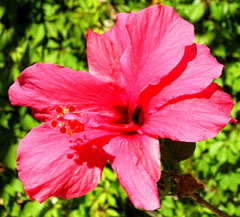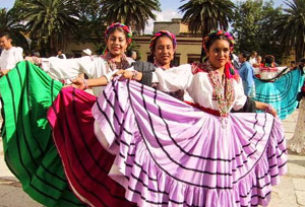Sometime between mid-March and early April, there comes a day when the temperature suddenly climbs here in Central Mexico, marking the onset of the “hot season.” And with it comes a proliferation of stands selling seafood cocktails, ice cream and fruit drinks.
The fruit drinks, or aguas, are sold year round, but business picks up during the hot months. They make a beautiful picture lined up on street and market stands in their clear glass containers, and perhaps the most attractive of all is the deep ruby colored agua de jamaica, made from roselle hibiscus.

This agua has lately been adopted by creative Mexican chefs for use in a variety of both sweet and savory dishes, including marinades, sauces, sorbets, granitas, jellies and trendy cocktails. Its intense color and tart flavor are just the kind of characteristics chefs look for in the constant quest for originality. (I wouldn’t be surprised if Jamaica should turn up as the key ingredient on an episode of Iron Chef, which Mexican audiences watch with the same enthusiasm as those in the U.S.)
Jamaica is usually translated as hibiscus, but more than 300 species of hibiscus are found throughout the tropical and subtropical regions of the world, and only the edible variety, Hibiscus sabdariffa, is the one used in Mexican cooking. This species is variously known in English as roselle, red sorrel and Jamaica sorrel, which is probably how it came to be known in Mexico as Jamaica (pronounced ham-EYE-kah.)
Agua de jamaica is made from the dried calyx, or outer circle of leaves, of roselle blossoms. Sold by weight in the market, or in packages in the supermarket, the best dried roselle retains some softness and a beet-red color.
The basic proportion for making the agua is a cup of dried flowers to a quart of water. About six tablespoons of sugar per quart will provide enough sweetness without overwhelming the refreshingly tart taste of jamaica. It can be made on the stovetop or, in warm weather, left to steep like sun tea. For some savory recipes, the sugar is left out.
Unsweetened agua de jamaica, combined with garlic and herbs, makes a good marinade for lamb. And it seems to go equally well with seafood. Recently, I had a seafood brochette with jamaica sauce at a restaurant in Oaxaca, and a friend described a ceviche with hibiscus-lime marinade served in Puerto Escondido. The jamaica sauce I had in Oaxaca would probably go well with chicken or pork, in the same way that fruit sauces do.
And it seems that no ingredient is immune from the inventive “mixology” of bartenders looking for yet another version of the margarita or martini. In the case of jamaica, this has been wildly successful, producing cocktails with visual appeal and refreshing flavor. I am not a gin drinker, but last week in Puebla I tried a jamaica gin martini that may be one of the best cocktails I’ve tasted, with the jamaica complimenting, but not overwhelming, the taste of good English gin. My fellow taste tester, a martini purist prepared to dislike the drink, ended up having one himself.
In the dessert category, jamaica shows up in sorbets, granitas, syrups and gelatins. For gelatin, it is good combined with all kinds of berries and with sparkling wine. And some sweetened agua de jamaica makes a nice cooler with sparkling wine, served in a tall glass with a hierba buena mint garnish. Or just freeze the agua de jamaica in ice cube trays and drop the bright red cubes into a batch of white wine sangria.
A Hibiscus sabdariffa product I’ve seen lately is “hibiscus salt,” a Spanish specialty available on the internet. I haven’t ordered it yet, but aficionados say it’s good on fish, sliced tomatoes and Cornish game hens. The color looks so bright that I think it must be made with fresh flowers.
Jamaica is high in vitamin C and is a natural diuretic. It is sometimes recommended by Mexican herbalists as a remedy for high blood pressure, although I’ve read that those taking prescription diuretics should not drink too much agua de jamaica, which would presumably lower pressure further.
Buy jamaica at the market stalls where dried chiles are sold. These places usually specialize in dried ingredients and have a greater turnover. Look for flowers that are still somewhat soft, and avoid brittle texture and musty odor. Outside Mexico, the best bet is to shop for dried jamaica in Mexican markets, although several supermarkets, like Trader Joe’s, sell it in the dried produce or ethnic food sections. Or order it online from www.mexgrocer.com
Following are some of the jamaica recipes I’ve found, tasted, tweaked, and enjoyed.
- Hibiscus flower tea: Agua de jamaica
- Roselle hibiscus Martini: Martini de jamaica
- Roselle hibiscus marinated roast leg of lamb: Carnero en marinada de jamaica
- Hibiscus flower sorbet: Sorbet de jamaica


